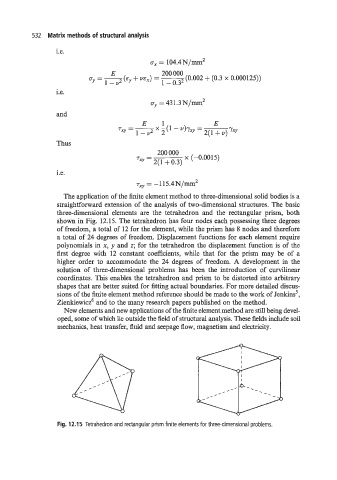Page 551 - Aircraft Stuctures for Engineering Student
P. 551
532 Matrix methods of structural analysis
i.e.
a, = 104.4N/mm2
E 200 000
cy = - (Ey + V&,) = ~ 1 - 0.32 (0.002 + (0.3 x 0.000125))
i.e.
cy = 43 1.3 N/EIIII~
and
E l E
x-(l-v)yxy=-
7.y = -
1-v2 2 2(1 +v)rx1'
Thus
2ooooo x (-0.0015)
7;cr = 2( 1 + 0.3)
i.e.
rxy = -115.4N/mm2
The application of the finite element method to three-dimensional solid bodies is a
straightforward extension of the analysis of two-dimensional structures. The basic
three-dimensional elements are the tetrahedron and the rectangular prism, both
shown in Fig. 12.15. The tetrahedron has four nodes each possessing three degrees
of freedom, a total of 12 for the element, while the prism has 8 nodes and therefore
a total of 24 degrees of freedom. Displacement functions for each element require
polynomials in x, y and z; for the tetrahedron the displacement function is of the
first degree with 12 constant coefficients, while that for the prism may be of a
higher order to accommodate the 24 degrees of freedom. A development in the
solution of three-dimensional problems has been the introduction of curvilinear
coordinates. This enables the tetrahedron and prism to be distorted into arbitrary
shapes that are better suited for fitting actual boundaries. For more detailed discus-
sions of the finite element method reference should be made to the work of Jenkins5,
Zienkiewicz6 and to the many research papers published on the method.
New elements and new applications of the finite element method are still being devel-
oped, some of which lie outside the field of structural analysis. These fields include soil
mechanics, heat transfer, fluid and seepage flow, magnetism and electricity.
Fig. 12.1 5 Tetrahedron and rectangular prism finite elements for three-dimensional problems.

